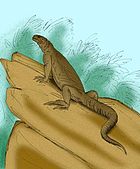Bicuspidon is an extinct genus of polyglyphanodont lizard known from the Late Cretaceous of North America, Europe and Africa, two species, B. numerosus[1] and B. smikros[2] are known from the Cenomanian of Utah in the Mussentuchit Member of the Cedar Mountain Formation and the Naturita Formation respectively. While B. hatzegiensis is known from the Maastrichtian Sânpetru Formation of Romania[3] and B. hogreli is known from the Cenomanian Kem Kem Beds of Morocco.[4] An indeterminate taxon closely related to B. hatzegiensis referred to as B. aff. hatzegiensis is known from the Santonian Csehbánya Formation of Hungary.[5] The dentition is heterodont, with conical anterior teeth and transversely oriented bicuspid posterior teeth. Analysis of dental microwear and macrowear patterns and jaw and tooth morphology of Bicuspidon specimens from the Csehbánya Formation suggests that it had a diverse diet consisting of both soft and hard food items.[6]
References
- ^ Nydam, Randall; Cifelli, Richard (2002). "A new teiid lizard from the Cedar Mountain Formation (Albian–Cenomanian boundary) of Utah". Journal of Vertebrate Paleontology. 22 (2): 276–285. doi:10.1671/0272-4634(2002)022[0276:ANTLFT]2.0.CO;2.
- ^ L., Titus, Alan (2013). At the Top of the Grand Staircase : the Late Cretaceous of Southern Utah. Loewen, Mark A. Bloomington, IN: Indiana University Press. ISBN 9780253008961. OCLC 857365429.
{{cite book}}: CS1 maint: multiple names: authors list (link) - ^ Folie, Annelise; Codrea, Vlad (January 2005). "New lissamphibians and squamates from the Maastrichtian of Haţeg Basin, Romania". Acta Palaeontologica Polonica. 50 (1): 57–71.
- ^ Romain Vullo; Jean-Claude Rage (2018). "The first Gondwanan borioteiioid lizard and the mid-Cretaceous dispersal event between North America and Africa". The Science of Nature. 105 (11–12): Article 61. doi:10.1007/s00114-018-1588-3. PMID 30291449.
- ^ Makádi, László (December 2006). "Bicuspidon aff. hatzegiensis (Squamata: Scincomorpha: Teiidae) from the Upper Cretaceous Csehbánya Formation (Hungary, Bakony Mts)" (PDF). Acta Geologica Hungarica. 49 (4): 373–385. doi:10.1556/ageol.49.2006.4.5. ISSN 0236-5278.
- ^ Gere, Kinga; Bodor, Emese Réka; Makádi, László; Ősi, Attila (2 December 2021). "Complex food preference analysis of the Late Cretaceous (Santonian) lizards from Iharkút (Bakony Mountains, Hungary)". Historical Biology. 33 (12): 3686–3702. doi:10.1080/08912963.2021.1887862. ISSN 0891-2963. Retrieved 11 January 2025 – via Taylor and Francis Online.


















You must be logged in to post a comment.